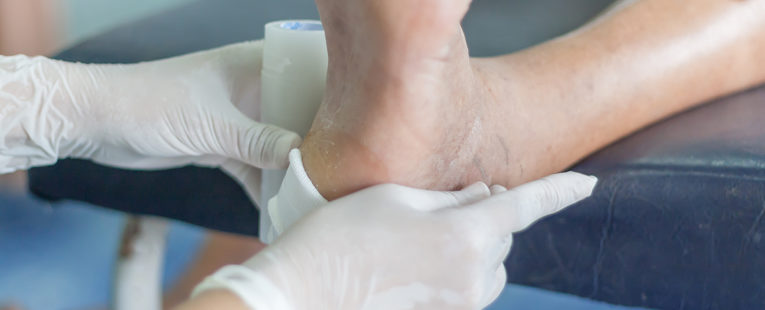An estimated 30.3 million people in the U.S. have diabetes. The percentage of adults with diabetes increases with age, reaching a high of 25.2 percent among those age 65 or older.
Diabetes may be accompanied by other coexisting conditions such as blindness, heart disease, kidney failure or lower-limb amputation.
High blood sugar levels, poor circulation, immune system issues, nerve damage and infection may contribute to a nonhealing diabetic foot ulcer, according to Heather Hawkins, program director of the OSF Wound Care Clinic in Bloomington. Approximately 15 percent of people living with diabetes will develop a foot ulcer.
Advanced treatment options

Medical office assistant Brandee Thrasher adjusts the settings on a hyperbaric oxygen chamber for a patient at the OSF Wound Care Clinic.
Mark Tate, 59, of Leroy, has been visiting the OSF Wound Care Clinic for much of this year due to chronic non-healing wounds on his feet. His healing process has been compromised due to type 2 diabetes.
“Although Mark has not fully healed at this time, healing is in sight for him due to regular visits to the OSF Wound Care Clinic and advanced treatment options, like hyperbaric oxygen and negative pressure wound therapy,” Hawkins said.
An estimated 14 to 24 percent of diabetes patients with foot ulcers will experience an amputation. Even more alarming, people with an amputation have a 50 percent mortality rate within five years.
“The OSF Wound Care Clinic has decreased Mark’s number of hospital admissions due to his nonhealing wounds and has greatly diminished the possibility of any future amputation,” Hawkins said.
Prevention strategies
The OSF Wound Care Clinic recommends the following to help prevent diabetic foot ulcers:
- Stop smoking immediately.
- Receive comprehensive foot examinations each time you visit your health care provider (at least four times a year).
- Perform a daily self-inspection of the feet, or have a family member perform the inspection.
- Maintain regular care of the feet, including cleaning toenails and taking care of corns and calluses.
- Choose supportive, proper footwear (shoes and socks).
- Take steps to improve circulation, such as eating healthier and exercising on a regular basis.
Last Updated: February 21, 2019
